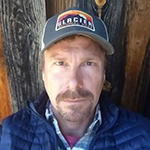You are browsing the archive for blue ridge Archives - Page 2 of 11 - Mountain Beltway.
19 January 2018
Friday fold: crumpled quartz vein from VGFC
Remember the Virginia Geological Field Conference from back in October? Well here’s a folded quartz vein we observed along a small shear zone in the Blue Ridge basement complex. There are two views of it, from approximately perpendicular points of view: These rocks are Mesoproterozoic, but the vein would obviously be younger than that, and the deformation is likely Alleghanian in age (late Paleozoic). Annotated copies of the photos:
27 October 2017
Friday fold: Quantankerous veins
What does it mean for a vein to be “quantankerous?” Well, to start with, it’s quartz. Second, it has to be disagreeable or cantankerous. This vein, seen in meta-arkose of the Catoctin Formation near the summit of the Blue Ridge at Rockfish Gap (not Afton Mountain), is such a quantankerous individual: You’ll notice its “S” shape, which might imply top-to-the-left kinematics. But just down the outcrop is this set of …
18 October 2017
VGFC 2017: Limbs of arkose
The 2017 Virginia Geological Field Conference had a heavy arkose infusion. Meet some of these feldspar-rich Neoproterozoic sediments of the Lynchburg Group.
15 April 2017
Basement xenoliths in Catoctin Formation, Compton Pass
My son and I hiked Compton Peak in Shenandoah National Park this morning, and saw these two lovely examples of xenoliths. The example above is small, but it shows clearly the difference between the coarse, felsic basement rock (Mesoproterozoic granitoid, comprising the xenolith) and the surrounding fine-grained dark green metabasalt of the Catoctin Formation (Neoproterozoic). Here’s another, bigger example: These two Blue Ridge examples both illustrate the principle of relative …
6 June 2016
Cleavage refraction in Konnarock Fm. rhythmites – a virtual sample
Here’s a visualization combination that leverages the advantages of the GIGAmacro system with the 3D ‘virtual sample’ perspective of the Sketchfab-hosted model: the same sample presented in both formats. In this case, it’s a lovely example of cleavage refraction going from meta-clay-shale (now ‘slate’) through a graded bed of fine sand and silt. Link GIGAmacro by Callan Bentley Photoscan model by Marissa Dudek The sample is of the Neoproterozoic Konnarock …
20 April 2016
Cooling columns of the Catoctin Formation, Indian Run Overlook, Shenandoah National Park
An inaugural visit to an outcrop in Shenandoah National Park reveals the signature of lava flows ~600 million years old.
2 April 2016
Five new GIGAmacro images
Here are a few new images I’ve been working on with my home-based Magnify2 imaging system from GIGAmacro. Strophomenid brachiopods from Mississippian Mauch Chunk Formation, West Virginia: Link Boninite from New Caledonia: Link Lepidodendron scale-tree bark from Poland: Link Potassium feldspar crystal, from a pegmatite: Link Catoctin Formation greenstone from a feeder dike east of Linden, Virginia: Link Enjoy exploring them for details.
31 March 2016
This week’s batch of 3D models
Anorthosite with lovely garnet reaction rims, a spherical hematite concretion, and some sweet breccia. Check them out and explore!
29 March 2016
Four new GIGAmacro images
Here are a few new images I’ve been working on with my home-based Magnify2 imaging system from GIGAmacro. Archean basement complex gneiss from the Gallatin Range of Montana: Link (If this looks familiar, that’s because one of the samples I imaged with the Photoscan 3D modeling technique and published on Sketchfab the week before last.) Banded iron formation from Minnesota with ooids and stromatolites: Link Intrusion breccia: Link Blue Ridge …
15 January 2016
Friday fold: Harpers Ferry
The geology east of Harpers Ferry, West Virginia, is cool. It’s Blue Ridge rocks, from basement to the cover sequence, tilted to the west and broken and repeated by the Short Hill Fault. Here’s a look at a detail of the Geology of the Harpers Ferry quadrangle by Southworth and Brezinski (1996). So there’s a fault! Good – but the title of this post isn’t “Friday fault” – Where’s the …


 Callan Bentley is Associate Professor of Geology at Piedmont Virginia Community College in Charlottesville, Virginia. He is a Fellow of the Geological Society of America. For his work on this blog, the National Association of Geoscience Teachers recognized him with the James Shea Award. He has also won the Outstanding Faculty Award from the State Council on Higher Education in Virginia, and the Biggs Award for Excellence in Geoscience Teaching from the Geoscience Education Division of the Geological Society of America. In previous years, Callan served as a contributing editor at EARTH magazine, President of the Geological Society of Washington and President the Geo2YC division of NAGT.
Callan Bentley is Associate Professor of Geology at Piedmont Virginia Community College in Charlottesville, Virginia. He is a Fellow of the Geological Society of America. For his work on this blog, the National Association of Geoscience Teachers recognized him with the James Shea Award. He has also won the Outstanding Faculty Award from the State Council on Higher Education in Virginia, and the Biggs Award for Excellence in Geoscience Teaching from the Geoscience Education Division of the Geological Society of America. In previous years, Callan served as a contributing editor at EARTH magazine, President of the Geological Society of Washington and President the Geo2YC division of NAGT.